++整理版物流思考题
物流管理思考题答案要点

第一章思考题答案要点:1. 沃尔玛高效的物流系统为货物的及时送达带来了保障。
(1)强大的仓储和配送能力是物流保障的基础。
(2)完善的信息系统保障了信息的及时送达。
(3)自动化的物流技术贯穿整个物流过程。
(4)物流系统是多个要素有效协作的结果。
2. 沃尔玛作为先进物流实施的代表给我国零售业企业物流发展指明了关键路径。
(1)物流系统是多个要素协同发展的基础,需要多方配合,因此均衡发展影响物流的各系统是保障物流业平稳进步的基础。
(2)物流的发展和信息技术不可分割,相互促进,因此必须有效利用信息。
(3)物流系统投入大,中小零售企业建立独立的物流渠道不太现实,必须借助其他物流形式。
(4)大型零售企业为保障物流的高效性,将物流业务掌握在自己手中是可以借鉴的一种方法。
(5)物流的有效实现需要合理规划物流操作的每个步骤。
一、不定项选择1. B2. C3. AB4. A5. A6. A7. BDE8. ABCDE 9.ABCDE 10.BDE 11.ABE二、简答1. 什么是物流?答:物流是指物品从供应地到接受地的实体流动过程.根据实际需要,将运输、储存、装卸、搬运、包装、流通加工、配送、信息处理等基本功能实施有机结合。
2. 物流的功能有哪些?答:物流的功能大体分为主体功能、辅助功能以及信息管理功能。
其中(1)主体功能,主要包括:①运输。
②储存。
③配送。
(2)辅助功能,主要包括:①包装。
②装卸搬运。
③流通加工。
(3)信息管理功能。
3. “物流7R理论”主要是指什么?物流7R理论,即物流就是将恰当的质量(Right Quality)、恰当的数量(Right Quantity)、恰当的价格(Right Price)、恰当的商品(Right Commodity)、在恰当的时间(Right Time),送到恰当的场所(Right P1ace)、恰当的顾客(Right Customers)手中。
4. 简述什么是现代物流管理?它的基本原理包括哪些方面?答:现代物流管理是指在社会再生产过程中,根据物质资料实体流动的规律,应用管理的基本原理和科学方法,对物流活动进行计划、组织、指挥、协调、控制和监督,使各项物流活动实现最佳的协调与配合,以降低物流成本,提高物流效率和经济效益。
物流管理基础思考题

物流管理基础思考题物流管理基础复习思考题一、复习思考题1.什么是物流?什么是商流?二者有什么区别?2.简述物流管理的五大职能,并说明哪一个最重要?3.企业物流与社会物流什么区别?4.按业主类型,物流的分类是什么?5.物流经济活动的双重性表现在那?6.如何懂得物流系统能够使物流的总费用最省?7.简述现代物流的进展趋势?8.结合看的录像总结我国物流进展的现状及需解决的问题。
一、复习思考题答案1.什么是物流?什么是商流?二者有什么区别?答:物流,是物资有形或者无形地从供应者向需求者进行的物资物质实体的流淌。
具体的物流活动包含包装、装卸、运输、储存、流通加工与信息等诸项活动。
通过物流活动,能够制造物资的空间效用、时间效用,流通加工活动还可能制造物资的形质效用。
商流,是物资在由供应者向需求者转移时物资社会实体的流淌,要紧表现为物资与其等价物的交换运动与物资所有权的转移运动。
具体的商流活动包含买卖交易活动及商情信息活动。
商流活动能够制造物资的所有权效用。
区别:(1)流淌的实体不一致:物流是物资的物质实体的流淌,商流是物资的社会实体的流淌。
(2)功能不一致:物流制造物资的空间效用、时间效用、形质效用,而商流制造物资的所有权效用。
(3)物流与商流又是相互独立的,发生的先后与路径都可能互不相同。
在特殊情况下,没有物流的商流与没有商流的物流都是可能存在的。
2.简述物流管理的五大职能,并说明哪一个最重要?答:在物流管理五大职能中最重要的是计划。
计划,就是规划、策划。
要对整个物流活动进行全面的规划与策划,确定物流活动搞些什么,怎么搞。
物流活动,特别是物流数量大、物流时间长的物流活动,通常要动用较多的资源、涉及较多的人、车、库与较多的部门单位,通常是一个系统工程,因此一定要做好事前的规划与策划,选取最好的方案实施,这就是计划的过程。
3.企业物流与社会物流什么区别?答:社会物流是处在各个企业间的物流。
它包含企业相互间的购进物流、销售物流、返品物流、回收物流与废弃物流,社会物流是一种宏观物流,处在流通领域,通常都伴随着商流发生。
第6章物流管理思考题答案 现代企业管理复习思考题答案(第2版)
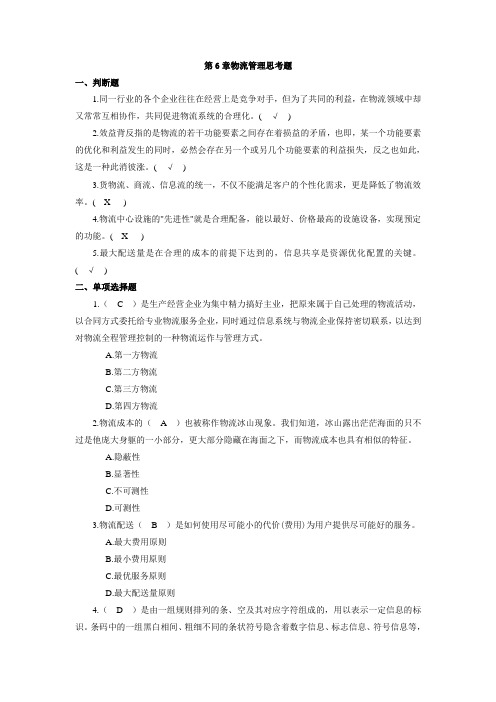
第6章物流管理思考题一、判断题1.同一行业的各个企业往往在经营上是竞争对手,但为了共同的利益,在物流领域中却又常常互相协作,共同促进物流系统的合理化。
( √)2.效益背反指的是物流的若干功能要素之间存在着损益的矛盾,也即,某一个功能要素的优化和利益发生的同时,必然会存在另一个或另几个功能要素的利益损失,反之也如此,这是一种此消彼涨。
( √)3.货物流、商流、信息流的统一,不仅不能满足客户的个性化需求,更是降低了物流效率。
( X )4.物流中心设施的"先进性"就是合理配备,能以最好、价格最高的设施设备,实现预定的功能。
( X )5.最大配送量是在合理的成本的前提下达到的,信息共享是资源优化配置的关键。
( √)二、单项选择题1.( C )是生产经营企业为集中精力搞好主业,把原来属于自己处理的物流活动,以合同方式委托给专业物流服务企业,同时通过信息系统与物流企业保持密切联系,以达到对物流全程管理控制的一种物流运作与管理方式。
A.第一方物流B.第二方物流C.第三方物流D.第四方物流2.物流成本的( A )也被称作物流冰山现象。
我们知道,冰山露出茫茫海面的只不过是他庞大身躯的一小部分,更大部分隐藏在海面之下,而物流成本也具有相似的特征。
A.隐蔽性B.显著性C.不可测性D.可测性3.物流配送(B)是如何使用尽可能小的代价(费用)为用户提供尽可能好的服务。
A.最大费用原则B.最小费用原则C.最优服务原则D.最大配送量原则4.( D )是由一组规则排列的条、空及其对应字符组成的,用以表示一定信息的标识。
条码中的一组黑白相间、粗细不同的条状符号隐含着数字信息、标志信息、符号信息等,主要用于表示商品的名称、产地、价格、种类,是国际通用的商品代码的表述方法。
A.激光技术B.射频识别C.二维码D.条形码5.利用( D )和电子地图可以实时显示出车辆的实际位置,实现多车辆同时跟踪。
A.GGSB.GSSC.GISD.GPS三、多项选择题1.物流管理分为(BCD),A.物流控制B.过程管理C.控制要素管理D.具体职能管理2.物流中心的功能有( ABC )A.连接功能B.收集、处理、传输信息功能C.管理功能D.设计的功能3.降低配送成本的方法有( ABCDE )。
物流工程第章复习思考题参考答案

物流工程第章复习思考题参考答案IMB standardization office【IMB 5AB- IMBK 08- IMB 2C】第3章物流系统设施选址决策复习思考题参考答案1.产品制造企业的物流设施与服务企业的的物流设施选址战略有哪些差异?参考答案(1)产品制造企业与服务企业的特点不同,如下表所示。
制造业与服务业的对比比较项目制造业服务业产品特征有形性有形性产品的可存储性高低产品的标准化程度高低客户的参与程度低高产业性质资本密集型劳动力密集型规模经济实现途径增加生产批量多店作业服务业的一个重要特点是通过多个分店来与顾客保持密切联系的。
所以,服务设施的选择与目标市场的确定紧密相关的。
对于服务业来说,由于服务项目难以运输到远处,那些需要与顾客直接接触的服务企业,其服务质量的提高有赖于与最终市场的接近与分散程度。
因此,服务设施必须靠近顾客群。
对于一个仓储或配送中心来说,与制造业的工厂选址一样,运输费用是需要考虑的一个重要因素,但快速接近市场可能更重要,可以缩短交货时间。
此外,对于制造业生产厂的选址来说,与竞争对手的相对位置有时并不重要。
而在服务业,就是一个非常重要的因素,服务业企业在进行设施选址时,不仅必须考虑竞争者的现有位置,而且还要估计他们对新选设施地址的反应。
对于商店、快餐店等服务企业来说,在竞争者附近设址有更多的好处,因为在这种情况下,可能会形成“聚集效应”,即受聚集在某地的几个公司所吸引而来的顾客总数,大于分布在不同地方的这几个公司的顾客总数。
(2)服务设施和生产设施选址影响因素不同服务设施和生产设施选址因素对比影响生产设施选址的因素主要包括有形成本(原材料、能源和公用设施成本)无形及未来成本(工会的态度、生活质量、教育支出、国家和地方的政策等)。
而服务设施选址过程中主要考虑业务和收入两个决定性因素,其中影响服务部门业务量和收入大小的主要有区域内的客户购买能力、服务部门服务和形象的兼容性、区域内的竞争强度和质量、企业的独特性及竞争对手的选址及其邻近区域商业和设施的质量、企业经营策略和管理水平等多个因素。
物流企业运行管理思考题答案

物流企业运行管理第一单元思考题答案1. 如何理解物流企业定义:(1)物流企业是专门从事物流活动的经济组织。
(2)物流企业是指具有运输、存储、装卸、搬运、包装、流通加工、、配送、信息处理等二个以上功能进行组织和管理,能够按照客户需求惊醒多功能及一体化运作的组织和管理,具有与自身业务相适应的信息管理系统,实行独立核算、独立承担民事责任的经济组织。
物流企业是组成物流产业的细胞,主要为生产企业服务,也为人民生活服务。
物流企业作为一个经济实体,为维系其生存和发展,具有自身的利益驱动机制,也具有健全的机制和旺盛的生命力;物流企业是市场经济的运行下,平等参与竞争,享有合法权益的法人。
2. 不同物流企业的特征(物流企业分类):运输型物流企业,以从事货物运输业务为主,包括货物快递服务或运输代理服务,具备一定规模;可以提供门到门、门到站、站到门、站到站运输服务和其他物流服务;企业自有一定数量的运输设备;具备网络信息化服务功能,应用信息系统可对运输货场进行状态查询、监督;按照客户要求,组织物流功能的延伸服务。
仓储型物流企业,以从事仓储业务为主,为客户提供储存、保管和中转等仓储业务,具备一定规模;企业能为客户提供配送服务以及商品经销、流通加工等其他服务;企业自有一定规模的仓储设施、设备,自有或租用必要的货运车辆;具备网络化信息服务功能,应用信息系统可对货物进行状态查询、监控。
综合服务型物流企业,从事多种物流服务业务,可以为客户提供运输、货运代理、仓储、配送等多种物流服务,具备一定规模;根据客户的需求,为客户制定整合物流资源的运作方案,为客户提供契约型的综合物流服务;按照业务要求,企业自有或租用必须的运输设备、仓储设施和设备;企业具有一定运营范围的货物集散、分拨网络;企业配置专门的机构和人员,建立完备的客户服务体系,能及时、有效地提供客户服务;具备网络化信息服务功能,应用信息系统可对物流服务全过程进行状态查询和监控。
(论述)3. 物流企业与企业物流的区别:(书上没有)物流企业:物流企业是专门从事物流活动的经济组织,是经济实体。
物流与供应链管理知识点与思考题整理

1.什么是第三方物流?什么是第四方物流?第三方物流:由物流劳务的供方、需方之外的第三方完成物流服务的物流运作方式,指专业物流企业在整合了各种资源后,为客户提供包括规划、解决方案以及具体物流业务运作等全部物流服务的物流活动,也称契约物流。
第四方物流:供应链的整合者和协调者,调配与管理组织本身与其他互补性服务所有的资源、能力和技术来提供综合的供应链解决方案。
2.什么是流通加工?流通加工与生产加工有何区别和联系?流通加工功能是在物品从生产领域向消费领域流动的过程中,为了促进产品销售、维护产品质量和实现物流效率化,对物品进行加工处理,使物品发生物理或化学性变化的功能。
流通加工的内容有装袋、定量化小包装、拴牌子、贴标签、配货、挑选、混装、刷标记等。
流通加工方式,是为了提高物流速度和物品的利用率,在物品进入流通领域后,按客户的要求进行的加工活动方式,而生产加工方式,是委托生产加工从事创造社会财富的活动和过程,包括物质财富、精神财富的创造和人自身的生育,亦称社会生产,通过一定工序和方式将原材料、半成品转化为目标需求的过程的活动方式。
流通加工是相对于生产加工而言,流通加工与生产加工相比较。
既有共同之处又有不同的特点。
(1)从加工的对象不同来说:流通加工的对象是进入流通领域的商品;生产加工的对象不是最终商品而是原材料、零配件、半成品。
(2)从加工程度的深浅来说:流通加工大都为简单加工,是生产加工的一种辅助和补充;而生产加工则较为复杂。
(3)从加工的目的不同来说:生产加工的目的是创造价值和使用价值;流通加工的目的是完善商品的使用价值并在对原商品不作大的改动情况下提高其价值。
(4)从组织加工者不同来说:流通加工的组织者是从事流通工作的商业企业或物流企业;而生产加工的组织者则是生产企业。
3.什么是物流系统?如何理解物流系统化的概念和内涵?物流系统是指在一定的时间和空间里,由所需位移的物资、物流设施、物流设备、人员和通信联系等若干相互制约的动态要素所构成的,以完成物流活动为目的,具有特定功能的有机整体。
物流 运输与配送 复习思考题及答案
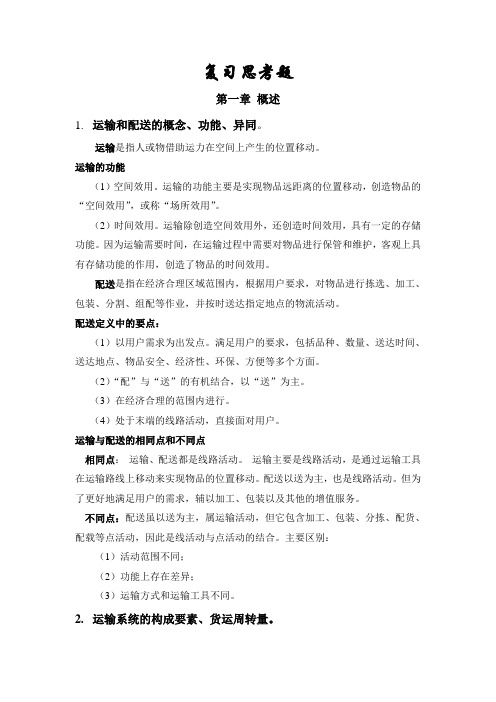
复习思考题第一章概述1.运输和配送的概念、功能、异同。
运输是指人或物借助运力在空间上产生的位置移动。
运输的功能(1)空间效用。
运输的功能主要是实现物品远距离的位置移动,创造物品的“空间效用”,或称“场所效用”。
(2)时间效用。
运输除创造空间效用外,还创造时间效用,具有一定的存储功能。
因为运输需要时间,在运输过程中需要对物品进行保管和维护,客观上具有存储功能的作用,创造了物品的时间效用。
配送是指在经济合理区域范围内,根据用户要求,对物品进行拣选、加工、包装、分割、组配等作业,并按时送达指定地点的物流活动。
配送定义中的要点:(1)以用户需求为出发点。
满足用户的要求,包括品种、数量、送达时间、送达地点、物品安全、经济性、环保、方便等多个方面。
(2)“配”与“送”的有机结合,以“送”为主。
(3)在经济合理的范围内进行。
(4)处于末端的线路活动,直接面对用户。
运输与配送的相同点和不同点相同点:运输、配送都是线路活动。
运输主要是线路活动,是通过运输工具在运输路线上移动来实现物品的位置移动。
配送以送为主,也是线路活动。
但为了更好地满足用户的需求,辅以加工、包装以及其他的增值服务。
不同点:配送虽以送为主,属运输活动,但它包含加工、包装、分拣、配货、配载等点活动,因此是线活动与点活动的结合。
主要区别:(1)活动范围不同;(2)功能上存在差异;(3)运输方式和运输工具不同。
2.运输系统的构成要素、货运周转量。
构成要素:运输线路、运输工具、运输参与者(货主、承运人、货运代理人、运输经济人)货运周转量:是指运输货物的数量(吨)与运输距离(公里)的乘积3.运输的基本原理。
规模原理是指随着一次装运量的增大,使每单位重量的运输成本下降。
(固定成本分摊到每单位物品的成本减少)距离原理是指运输成本与一次运输的距离有关,随着一次运输距离的增加,运输费用的增加会变得越来越缓慢,或者说单位运输距离的费用减少。
运输距离为零时,运输成本并不为零,这是因为存在一个与货物提取和交付有关的固定成本。
物流工程第4章 复习思考题参考答案
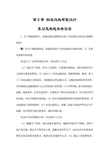
第4章物流设施布置设计复习思考题参考答案1.生产物流系统中,设施布置包括哪些内容?在布置设计时应注意哪些事项?答:在生产物流系统内,设施布置设计主要包括两方面的内容:工厂总体布置和车间布置。
在进行工厂总体布置设计时,应注意以下几点:(1)满足生产要求,符合工艺流程,尽量减少物流量,同时重视各部门之间的关系密切程度。
(2)适应工厂内外运输要求,线路要短捷、顺直,要与工厂内部运输方式相适应,并根据选定的运输方式、运输设备和技术要求等,合理地确定运输线路及与之有关的部门的位置。
(3)合理用地,充分利用地形、地貌、地质条件。
企业在建设中,在确保生产和安全的前提下,应尽量合理节约用地,并适当预留发展用地。
(4)充分考虑建筑群体的空间组织和造型,以及建筑施工的便利条件。
(5)充分注意防火、放爆、防损与防噪声等安全生产问题。
充分利用当地自然条件,减少环境污染。
在进行车间布置设计时,应注意以下几点:(1)根据生产要求,确定设备布置形式。
根据车间的生产纲领,分析产品产量关系,确定生产类型是大量、成批还是单件生产,由此决定车间设备布置形式是采用流水线形式、机群式还是成组单元式。
(2)满足工艺流程要求。
车间布置应保证工艺流程顺畅、物料搬运方便,减少或避免往返交叉等物流现象。
(3)选择适当的建筑形式。
根据工艺流程要求及产品特点,配备适当等级的起重运输设备,进一步确定建筑物高度、跨度及外形。
(4)实行定置管理,确保工作环境整洁、安全。
除了要对主要生产设备安排适当位置外,还需对其他所有组成部分包括在制品暂存地、废料存放地、工人工作地、通道、辅助部门,如办公室、生活卫生设施等安排合理的位置,确保工作环境整洁及生产安全。
(5)应注意采光、照明、通风、采暖、防尘、防噪,并使布置具备适当的柔性,以适应生产的变化。
2.物料流动的基本模式有哪些?各有何特点?答:物料流动模式有水平和竖直两种,其中水平模式是最基本的,常见的有5种基本流动模式,直线形、L形、U形、环形和S形。
物流工程第5章复习思考题参考答案

物流⼯程第5章复习思考题参考答案第5章物料搬运系统分析复习思考题及答案1. 什么是物料搬运?物料搬运包含哪⼏项主要活动,各有什么含义?答:所谓物料搬运,通俗地讲,是指在同⼀地域范围内进⾏的,以改变货物的存放状态和空间位置为主要内容和⽬的的活动,具体包括装上、卸下、移动、拣选、分类、堆垛、⼊库、出库等活动。
2. 什么是物料搬运系统?物料搬运⽅法和搬运设备应如何进⾏选择?答:物料搬运系统是指通过⼀系列的搬运设备和装置,⽤于⼀个过程或逻辑动作系统中,协调、合理地将物料进⾏移动、储存或控制。
在⼯作中,可根据距离与物流指⽰图初步选择不同搬运设备和搬运线路的类型。
3. 何谓物料搬运程式?你能⽤5W1H⽅法来解决MH问题吗?答:物料搬运系统分析和设计是⼗分复杂的,为了合理科学地对物料搬运系统进⾏分析,有学者提出了“物料搬运⽅程式”这⼀分析⼿段,即著名的5W1H法,可更加系统全⾯分析物料搬运系统中物料、移动和⽅法等⽅⾯。
4. 物料搬运系统分析的四个阶段、三⼤内容、程序模式是什么?答:四个阶段:外部衔接分析、编制总体搬运⽅案、编制详细搬运⽅案和⽅案的实施。
三⼤内容:物料、移动和⽅法。
程序模式包括:物料分类、系统布置分析、移动的分析、各项移动的图表化、初步搬运⽅案选择、⽅案的修改和限制、各项需求的计算、⽅案的评价和详细搬运⽅案的设计等⽅⾯。
5. 将SLP和SHA结合起来进⾏物流系统分析和设计的意义何在?答:SLP和SHA⼀脉相承、关系密切,在设计时可以相互结合、相互交叉、相互补充,使这两部分⼯作能得到较为完善的结合,使得设计出来的⽅案更加合理,实现物流合理化。
6. 物料搬运(MH)有20条重要原则,这是处理⼀切物料搬运问题的基础,你能将其归纳为⼏个⽅⾯?使其变成更少的准则吗?答:物料搬运的20条原则是物料搬运专家的经验总结,可作为我们物料搬运设计的借鉴,但它不应该成为我们墨守成规的条⽂,在⽇常⼯作中,我们可以根据⾃⼰的⼯作和学习经验进⾏再整理,做到理论与实践相结合。
物流管理考试题
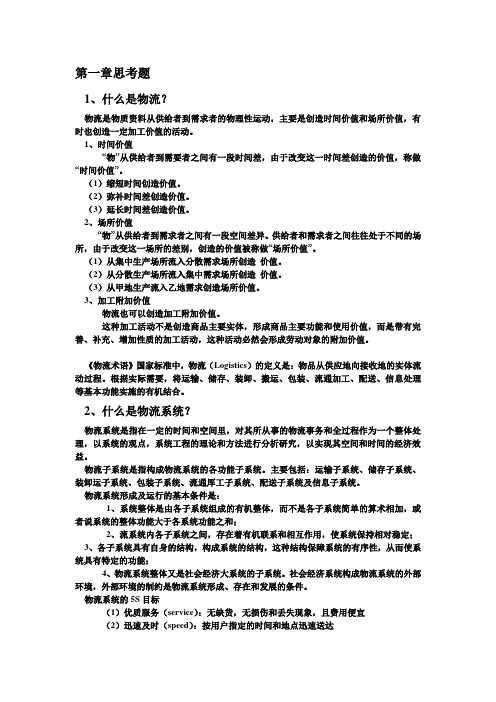
第一章思考题1、什么是物流?物流是物质资料从供给者到需求者的物理性运动,主要是创造时间价值和场所价值,有时也创造一定加工价值的活动。
1、时间价值“物”从供给者到需要者之间有一段时间差,由于改变这一时间差创造的价值,称做“时间价值”。
(1)缩短时间创造价值。
(2)弥补时间差创造价值。
(3)延长时间差创造价值。
2、场所价值“物”从供给者到需求者之间有一段空间差异。
供给者和需求者之间往往处于不同的场所,由于改变这一场所的差别,创造的价值被称做“场所价值”。
(1)从集中生产场所流入分散需求场所创造价值。
(2)从分散生产场所流入集中需求场所创造价值。
(3)从甲地生产流入乙地需求创造场所价值。
3、加工附加价值物流也可以创造加工附加价值。
这种加工活动不是创造商品主要实体,形成商品主要功能和使用价值,而是带有完善、补充、增加性质的加工活动,这种活动必然会形成劳动对象的附加价值。
《物流术语》国家标准中,物流(Logistics)的定义是:物品从供应地向接收地的实体流动过程。
根据实际需要,将运输、储存、装卸、搬运、包装、流通加工、配送、信息处理等基本功能实施的有机结合。
2、什么是物流系统?物流系统是指在一定的时间和空间里,对其所从事的物流事务和全过程作为一个整体处理,以系统的观点,系统工程的理论和方法进行分析研究,以实现其空间和时间的经济效益。
物流子系统是指构成物流系统的各功能子系统。
主要包括:运输子系统、储存子系统、装卸运子系统、包装子系统、流通厍工子系统、配送子系统及信息子系统。
物流系统形成及运行的基本条件是:1、系统整体是由各子系统组成的有机整体,而不是各子系统简单的算术相加,或者说系统的整体功能大于各系统功能之和;2、流系统内各子系统之间,存在着有机联系和相互作用,使系统保持相对稳定;3、各子系统具有自身的结构,构成系统的结构,这种结构保障系统的有序性,从而使系统具有特定的功能;4、物流系统整体又是社会经济大系统的子系统。
[精品]物流复习思考题.doc
![[精品]物流复习思考题.doc](https://img.taocdn.com/s3/m/997e3f257fd5360cbb1adb31.png)
4.供应链管理:一、名词解释1?物流:是指物品从供应地向接收地的实体流动过程。
2.商物分离:是指流通屮两个组成部分即商业流通和实物流通各口按照口己的规律和渠道独立运动。
3.物流服务:是供给方向需求方提供的与实物的吋间和空间运动相关联的服务。
这个过程使交易111的产品或服务实现增值。
就是对整个供应链屮各部门、各组织之间的物流、信息流、资金流进行计划、协调和控制,实现相关过程的最优化,为顾客提供最佳服务和最人价值,同时使供应链的运作效率和效益最优、。
5?物流成本:物流活动屮所消耗的物化劳动和活劳动的货币表现。
6.物流管理:是供应链管理的一?部分,以满足顾客需求为FI 的,对货物、服务和相关信息在产出地和消费地之间的有效、高效的正向和反向流动与存储进行计划、执行和控制。
7.现代物流:指的是将信息、运输、仓储、库存、装卸搬运以及包装等物流活动综合起来的一种新型的集成式管理,其任务是尽可能降低物流的总成本,为顾客提供最好的服务。
8.物流园区:是指在物流作业集屮的地区,在几种运输方式衔接地,将多种物流设施和不同类型的物流企业在空间上集屮布局的场所,也是一个有一定规模的和具有多种服务功能的物流企业的集结点。
9.绿色物流:是指以降低污染物排放、减少资源消耗为H 标,通过先进的物流技术和面向环境管理的概念,进行物流系统的规划、控制、管理和实施的过程。
10.物流外包:制造企业或销售等企业为集屮资源、节省管理费用,增强核心竞争能力,将其物流业务以合同的方式委托给专业的物流公司(第三方物流,3PL )运作。
11.第三方物流:由供方和需方以外的物流企业提供物流服务的业务模式。
12.物流市场:是指为保证牛产和流通过程顺利进行而形成的为商品流动和暂时停留提供服务的服务性市场,其功能主要有资源配置、实现规模经济和集约经济、提咼物流效率、降低物流成本等。
13.第四方物流:专门为第一方、第二方和第三方提供物流规划、咨询、物流信息系统、供应链管理等活动。
物流工程第3章 复习思考题参考答案

第?3?章物流系统设施选址决策复习思考题参考答案1.产品制造企业的物流设施与服务企业的的物流设施选址战略有哪些差异参考答案(1)产品制造企业与服务企业的特点不同,如下表所示。
制造业与服务业的对比比较项目制造业服务业产品特征有形性有形性产品的可存储性高低产品的标准化程度高低客户的参与程度低高产业性质资本密集型劳动力密集型规模经济实现途径增加生产批量多店作业服务业的一个重要特点是通过多个分店来与顾客保持密切联系的。
所以,服务设施的选择与目标市场的确定紧密相关的。
对于服务业来说,由于服务项目难以运输到远处,那些需要与顾客直接接触的服务企业,其服务质量的提高有赖于与最终市场的接近与分散程度。
因此,服务设施必须靠近顾客群。
对于一个仓储或配送中心来说,与制造业的工厂选址一样,运输费用是需要考虑的一个重要因素,但快速接近市场可能更重要,可以缩短交货时间。
此外,对于制造业生产厂的选址来说,与竞争对手的相对位置有时并不重要。
而在服务业,就是一个非常重要的因素,服务业企业在进行设施选址时,不仅必须考虑竞争者的现有位置,而且还要估计他们对新选设施地址的反应。
对于商店、快餐店等服务企业来说,在竞争者附近设址有更多的好处,因为在这种情况下,可能会形成“聚集效应”,即受聚集在某地的几个公司所吸引而来的顾客总数,大于分布在不同地方的这几个公司的顾客总数。
(2)服务设施和生产设施选址影响因素不同服务设施和生产设施选址因素对比影响生产设施选址的因素主要包括有形成本(原材料、能源和公用设施成本)无形及未来成本(工会的态度、生活质量、教育支出、国家和地方的政策等)。
而服务设施选址过程中主要考虑业务和收入两个决定性因素,其中影响服务部门业务量和收入大小的主要有区域内的客户购买能力、服务部门服务和形象的兼容性、区域内的竞争强度和质量、企业的独特性及竞争对手的选址及其邻近区域商业和设施的质量、企业经营策略和管理水平等多个因素。
(3)产品制造企业与服务企业的选址原则不同对于制造业而言,不同的选址常常引起成本的显着差异。
物流思考题答案.doc
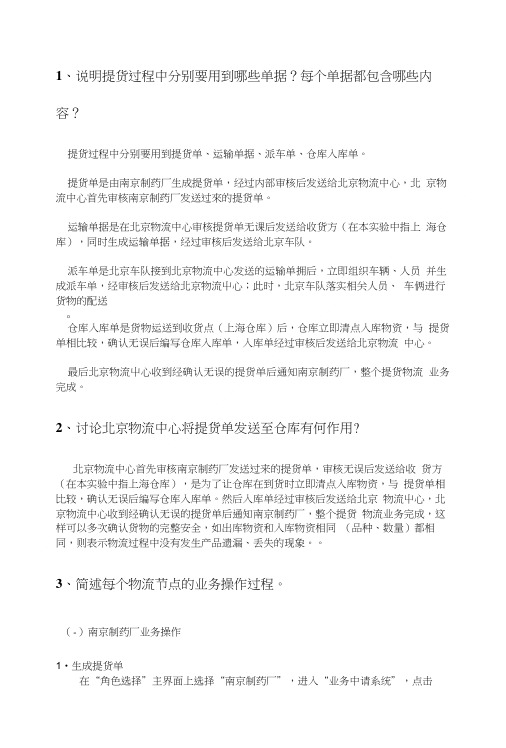
1、说明提货过程中分别要用到哪些单据?每个单据都包含哪些内容?提货过程中分别要用到提货单、运输单据、派车单、仓库入库单。
提货单是由南京制药厂生成提货单,经过内部审核后发送给北京物流中心,北京物流中心首先审核南京制药厂发送过來的提货单。
运输单据是在北京物流中心审核提货单无课后发送给收货方(在本实验中指上海仓库),同时生成运输单据,经过审核后发送给北京车队。
派车单是北京车队接到北京物流中心发送的运输单拥后,立即组织车辆、人员并生成派车单,经审核后发送给北京物流屮心;此时,北京车队落实相关人员、车俩进行货物的配送O仓库入库单是货物运送到收货点(上海仓库)后,仓库立即清点入库物资,与提货单相比较,确认无误后编写仓库入库单,入库单经过审核后发送给北京物流中心。
最后北京物流屮心收到经确认无误的提货单后通知南京制药厂,整个提货物流业务完成。
2、讨论北京物流中心将提货单发送至仓库有何作用?北京物流中心首先审核南京制药厂发送过来的提货单,审核无误后发送给收货方(在本实验中指上海仓库),是为了让仓库在到货时立即清点入库物资,与提货单相比较,确认无误后编写仓库入库单。
然后入库单经过审核后发送给北京物流屮心,北京物流中心收到经确认无误的提货单后通知南京制药厂,整个提货物流业务完成,这样可以多次确认货物的完整安全,如出库物资和入库物资相同(品种、数量)都相同,则表示物流过程中没有发生产品遗漏、丢失的现象。
3、简述每个物流节点的业务操作过程。
(-)南京制药厂业务操作1•生成提货单在“角色选择”主界面上选择“南京制药厂”,进入“业务中请系统”,点击“提货单”,“添加”添加发货、收货地址;运送产品种类、数量;如有特殊说明使用“备注”选项。
添制完毕后按“确定”选项。
2. 提货单审核具操作步骤和提货单生成相类似,选中将要进行审核的提货单,点击“审核”, 出现审核对话框,阅读具内容,确认无误后点击“审核”按钮,表示提货单已经经过“审核”。
物流学概论思考题重点资料
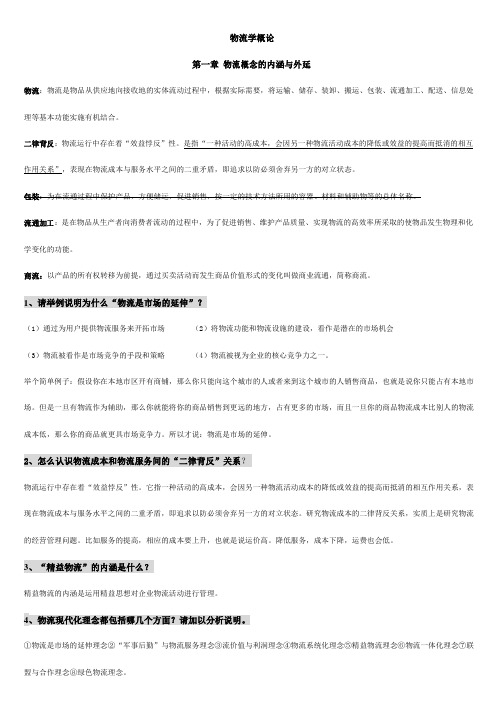
物流学概论第一章物流概念的内涵与外延物流:物流是物品从供应地向接收地的实体流动过程中,根据实际需要,将运输、储存、装卸、搬运、包装、流通加工、配送、信息处理等基本功能实施有机结合。
二律背反:物流运行中存在着“效益悖反”性。
是指“一种活动的高成本,会因另一种物流活动成本的降低或效益的提高而抵消的相互作用关系”,表现在物流成本与服务水平之间的二重矛盾,即追求以防必须舍弃另一方的对立状态。
包装:为在流通过程中保护产品,方便储运,促进销售,按一定的技术方法所用的容器、材料和辅助物等的总体名称。
流通加工:是在物品从生产者向消费者流动的过程中,为了促进销售、维护产品质量、实现物流的高效率所采取的使物品发生物理和化学变化的功能。
商流:以产品的所有权转移为前提,通过买卖活动而发生商品价值形式的变化叫做商业流通,简称商流。
(1)通过为用户提供物流服务来开拓市场(2)将物流功能和物流设施的建设,看作是潜在的市场机会(3)物流被看作是市场竞争的手段和策略(4)物流被视为企业的核心竞争力之一。
举个简单例子:假设你在本地市区开有商铺,那么你只能向这个城市的人或者来到这个城市的人销售商品,也就是说你只能占有本地市场。
但是一旦有物流作为辅助,那么你就能将你的商品销售到更远的地方,占有更多的市场,而且一旦你的商品物流成本比别人的物流成本低,那么你的商品就更具市场竞争力。
所以才说:物流是市场的延伸。
物流运行中存在着“效益悖反”性。
它指一种活动的高成本,会因另一种物流活动成本的降低或效益的提高而抵消的相互作用关系,表现在物流成本与服务水平之间的二重矛盾,即追求以防必须舍弃另一方的对立状态。
研究物流成本的二律背反关系,实质上是研究物流的经营管理问题。
比如服务的提高,相应的成本要上升,也就是说运价高。
降低服务,成本下降,运费也会低。
精益物流的内涵是运用精益思想对企业物流活动进行管理。
①物流是市场的延伸理念②“军事后勤”与物流服务理念③流价值与利润理念④物流系统化理念⑤精益物流理念⑥物流一体化理念⑦联盟与合作理念⑧绿色物流理念。
现代物流复习思考题及答案

(2) 现代储存管理在流通领域中的作用:储存时平衡市场供求关系,稳定物价的重要条件;仓储式物资管理工作的重要组成部分;现代仓储式保持物资原有使用价值的重要手段。
(3) 现代仓储管理在企业经营中的作用:在采购,生产,销售的不断循环过程中,库存是各个环节相对独立的经济活动成为可能。同时,仓储可以调节各个环节之间由于供求品种及数量的不一致而发生的变化,是采购,生产和销售等企业经营的各个环节连接起来,起到润滑作用。
论述题
1. 论述第三方物流客户服务的特性?
(1) 时间;从卖方的角度,时间因素通常以订单周期表示,从买方的角度则是备货时间或补货时间。影响时间因素有:订单传送,订单处理,订单准备,订单发送。
(2) 可靠性;可靠性不仅仅是备货时间上的一致性,还包括规则一致的备货时间,以及在安全和质量的均一性等条件下送达客户所订购的时间,还有订单的准确性。
价格激励;订单激励;商誉激励;信息激励;淘汰激励;新产品,新技术的共同开发;组织激励
论述题
1,。论述降低运输成本的方法?
( 1)通过简化运输系统,减少中间环节,降低运输成本(2)提高装载效率,降低运输成本(3)合理选择运输手段、降低运输成本(4)合理选择运输方式,降低运输成本(5)开展集运(6)优化运输路线(7)减少运输事故损失(8)降能具体有哪些?
货物集散功能;货物中转功能;配送功能;流通加工功能;口岸功能;商品检验;
物流信息服务;物流咨询与培训;商品展示的商流功能;电子商务的辅助功能;其他功能
1. 简述物流系统的特点?
1. )物流系统是一个“人机系统”(2).物流系统是一个大跨度系统(3).物流系统是一个可分系统(4).物流系统是一个动态系统(5).物流系统是一个复杂系统(6).物流系统是一个多目标系统
国际物流管理#思考题#

第02章物流基础-物流活动1,如何认识物流的产生与发展?答:物流的产生使社会发展尤其是市场化大生产的产物,由于生产与消费的时间和空间的不匹配,需要物流活动的协调。
随科技水平提高、分工细化、经济联系日益广泛,物流活动不断发展。
随自身技术与组织管理水平的提高,物流业更趋专业化、规模化。
物流业的发展从最初的物品运输逐渐成为独立的部门,自成体系;涉及很多方面,如采购、仓储、运输等。
物流业有广阔的市场并能创造巨大的财富。
2,现代物流的基本活动有哪些?答:1、运输活动;2、储存活动;3、包装活动;4、装卸搬运活动;5、流通加工活动;6、物流信息活动等。
3,简评物流科学的理论学说。
答:主要物流学说有:[1]商物分离学说;[2]黑大陆学说;[3]物流冰山学说;[4]第三利润源泉学说。
①,物流理论的发展还比较慢,尚未系统化、形式化,仍有待深入挖掘;②,物流业还被看做使辅助环节,实际上物流业会变成一个独立的部门,系统化;③,物流科学正在融合许多相邻学科的成果逐渐发展,如运筹学、技术经济学、系统工程等。
第03章物流基本环节(1)-运输、仓储与配送1,我国物流联运短路的原因包括哪些?为何要促进物流联运?答:①,基础设施建设不足,比如铁路、水运,需求巨大而供给不够,而过多依赖公路运输;②,不同运输工具间联接不方便,不能直接对钩,需要中转搬运,卸下装上;③,政府规划缺乏远见,我国大多港口都没有铁路直接修到港口实现对接;④,物流配送信息不畅,出现跑空情况,以及铁路运输需要等货配货,时间成本高,不灵活;⑤,不同运输方式间中转不顺畅,经常需要倒货;⑥,专业化的联运经理人少等。
通过物流联运,把各种运输方式合理配置应用,一个承运人,一票到底,实现“门对门”服务,全程整体供应链。
成本最小化,效益最大化,物品顺畅流通。
2,我国仓储难题的原因是什么?如何应对?答:①,土地成本高,仓库租金高;②,城市化不断发展,仓库不断拆迁,对仓库的需求不断扩大,而仓库面积增加慢;③,仓库条件差,单一面积的仓库少,卫生、采光、装修等不能满足电子商务的特殊要求;④,地方政府对仓储企业支持不够,更多的土地批给房地产等行业;⑤,税率较高,成本大;⑥,仓库布局不合理,政府规划缺位;⑦,仓储技术不发达,人力成本高。
整理版物流思考题

①Mike McNeely, logistics manager for the Illumination Light Company, has considered replacing the firm's manual customer order management system with electronic ordering, an EDI application. He estimates the current system, including labor, costs $2.50/order for transmission and processing when annual order volume is under 25,000. Should the order volume equal or exceed 25,000 in any given year, Mr. McNeely will have to hire an additional customer service representative to assist order reception in the manual process. This would raise the variable cost to $3.00/order. He has also estimated the rate of errors in order placement and transfer to be 12/1000 orders.EDI would cost $100,000 upfront to implement and variable costs are determined to be $0.50/order regardless of volume. EDI could acquire and maintain order information with an error rate of 3/1000 orders. An EDI specialist would be required to maintain the system at all times as well. Her salary is $38,000 in the first year and increases 3 percent each year thereafter.Order errors cost $5.00 per occurrence on average to correct in the manual system. EDI errors cost $8.00 on average to correct since the specialist inspects the system for flaws on most occasions.a. If the firm expects order volume over the next 5 years to be 20,000, 22,000, 25,000, 30,000, and 36,000 annually, would EDI pay for itself within the first 5 years?b. What effects aside from cost might Mr. McNeely consider when implementing EDI?a.To determine if EDI will pay for itself within the first 5 years,we must begin by determine the annual costs associated with the currents,manual customer order management system over this period:a.Manual: order cost error cost total cost1year: 20000x2.5+(12/1000)x20000x5=512002year: 22000x2.5+(12/1000)x22000x5=563203 year: 25000x3+(12/1000)x25000x5=765004 year: 30000x3+(12/1000)x30000x5=918005 year: 36000x3+(12/1000)x36000x5=110160b.EDI: device cost salary error cost order cost total cost 1year: 100000+38000 +20000x(3/1000)x8 +0.5x20000=1484802year: 38000x(1+3%)+22000x(3/1000)x8 +0.5x22000=506683 year: 38000x(1+3%)^2+25000x(3/1000)x8+0.5x25000=534144 year: 38000x(1+3%)^3+30000x(3/1000)x8+0.5x30000=57243.65 year: 38000x(1+3%)^4+36000x(3/1000)x8+0.5x36000=61633.3 test three1.Mr. Stan Busfield, distribution center manager for Hogan Kitchenwares, must determine when to resupply his stock of spatulas. The DC experiences a daily demand of 400 spatulas. The average length of the performance cycle for spatulas is 14 days. Mr. Busfield requires that 500 spatulas be retained as safety stock to deal with demand uncertainty.a. Use simple reorder point logic to determine the order quantity for spatulas.b. Based on your answer to part (a), find M r. Busfield’s average inventory level of spatulas.a. Use the reorder point to find the order quantity:R = D x T + SS= 400 x 14 + 500 = 6,100 spatulas reorder point is 6100, Order quantity is more than or equal to 5600. b. The average inventor is one-half the order quantity + safety sock:If Order quantity is equal to 5600, thenAverage inventory = 5600/2+500 = 3,300 spatulas4. Mr. John Eastes oversees the distribution of Tastee Sancks products from the plant warehouse to its two distribution centers in the United States. The plant warehouse currently has 42,000 units of the company’s most popular product, Chocolate Chewies. Mr. Estes retains 7000 units of the product at the warehouse as a buffer. The Cincinnati DC has an inventory of 12500 units and daily requirements of 2500 units. The Phoenix DC has an inventory of 6000 units and daily requirements of 2000 units.a. Determine the common days’ supply of Chocolate Chewies at each DC.b. Given the above information and your answer to part (a), use fair share allocation logic to determine the number of Chocolate Chewies to be allocated to each DC.a. Common days’ supply of chocolate chewies:DS = [(42,000 - 7,000) + 18,500]/4500=11.89 days (around) b. Fair Share Allocation Logic:Allocation = (Days’ Supply x Daily Requirements) - InventoryACincinnati = (11.89 x 2,500) - 12,500 = 17,225 unitsAPhoenix = (11.89 x 2,000) - 6,000 = 17,780 units Attention : Together, the allocations equal 35,005 units (17,225 + 17,780)which is 5 more than the plant warehouse’s allocation supply. The difference rests with the rounding of the days’ supply figure.2. Mr. Busfield recently completed a course in logistics management and now realizes that there are significant costs associated with ordering and maintaining inventory at his distribution center. Mr. Busfield has learned that the EOQ is the replenishment logic that minimizes these costs. In an effort to find the EOQ for measuring cups, Mr. Busfield has gathered relevant data. Mr. Busfield expects to sell 44,000 measuring cups this year. Hogan acquires the measuring cups for 75 cents each from Shatter Industries. Shatter charges $8 for processing each order. In addition, Mr. Busfield estimates his company's inventory carrying cost to be 12 percent annually.a. Find Mr. Busfield's EOQ for measuring cups. Assume that Mr. Busfield accepts ownership of products upon arrival at his DC.b. Now assume Mr. Busfield must arrange for inbound transportation of the measuring cups since Hogan accepts ownership of products at the supplier's shipping point. Quantities of fewer than 4000 measuring cups cost 5 cents per unit to ship. Quantities of 4000 and above cost 4 cents per unit to ship. Determine the difference in total costs associated with an EOQ of 4000 units and the EOQ level found in part (a) when transportation costs must be considered.c. Given the information above and the low cost EOQ alternative determined in part (b), use period-order-quantity logic to determine the number of orders Hogan would place each year for measuring cups and the time interval between orders.a. The economic order quantity (EOQ) is the square root of the product of the numerator (two times order cost and demand) divided by the product of the denominator (inventory carrying cost times unit cost): EOQ = 2,797 cups Annual total cost with order quantities of 2,797 cups ( calculated in part (a)): Inventory Carrying Costs = ( 2,797/2 ) x 0 .75 x 12% = $ 125.87to determine Order Costs, the number of whole orders/yr shall firstly be determined: (44,000/2797) = 15.73 -> roundup to 16 whole orders/yr.Oorder costs= 16 orders x $8 / order = $ 128.00Transportation Costs = 44,000 units x $0 .05 / unit = $ 2,200Total Cost ( EOQ = 2,797 units ) $ 2,453.87 /year Annual total cost with order quantities of 4,000 cups:Inventory Carrying Costs = (4,000/2) x 0.75x 0.12 = $ 180Order Costs : determine the number of whole orders/ yr.44,000 /4,000 = 11 whole orders/ yr11 orders x $8/order = $ 88Transportation Costs = 44,000 units x ($0.04/unit) = $1,760.00Total Cost ( EOQ' = 4,000 units) $ 2,028The order quantity of 4,000 units costs ( $2,453.87 – 2,028.00) $425.87 less annuallythan 2,797 order quantity found in part (a) when transportation costs are considered.Test 4:1. Super Performance Parts (SPP) produces braking devices exclusively for the Ace Motor company, an automotive manufacturer. SPP has been leasing warehouse space at a public facility 20 miles from the company's plant. SPP has been approached by a group of four other Ace suppliers with the idea of building a consolidated warehouse to gain transportation and materials handling economies. An investment of $200,000 would be required by each of the five companies to acquire the warehouse. Payment of the initial investment secures I0 years of participation in the agreement. Annual operating expenses are anticipated to be $48,000 for each party. SPP is currently charged $6000 per month for use of the public warehouse facilities.SPP's outbound transportation from the public warehouse often consists of LTL quantities. Its annual outbound transportation bill is currently $300,000. SPP expects consolidated warehousing to more fully utilize truckload quantities with transportation expenses shared among the supplier pool. SPP's annual outbound bill would be reduced by 25 percent in the consolidated plan. Differences in inbound transportation costs are assumed negligible in this case.a. Compare the storage and shipping costs associated with consolidated warehousing as opposed to SPP's current, direct shipping plan. Are any efficiencies apparent through consolidation?b. Aside from potentially reducing costs, how else might SPPbenetit by participating in the consolidated warehouse?c. What disadvantages might exist in a consolidated warehouse as opposed to a direct shipping situation?a. Direct Shipping Plan (annual costs)Storage costs: $6,000/month x 12 months = $ 72,000Shipping costs: = $ 300,000Annual total costs: $372,000Consolidated warehousing (annual costs)Storage costs: fixed $200,000/ 10 years = $ 20,000/yearOperations cost = $ 48,000Shipping costs: ($300,000) x (1 - 25%) = $ 225,000Annualtotalcosts: $293,000b. The consolidated warehouse can be operated for $79,000 less per year over the agreement’s tenyear life.This is a creative thinking question for the purpose of discussion. Key points may include but are not limited to: better customer service (in various forms) to Ace, synergy through coordination with partners, SPP may be able to utilize/share assets not financially feasible on their own. c. This too is a creative thinking question. Key points might be: added risk through ownership(part-ownership), potential difficulties with coordination across partners, incongruent++’s 物流大题4/4/2013objectives may lead to tribulations, and possible cash flow difficulties due to fixed investment expenditures2. Assume you are the logistics manager for a luggage company. All bags are produced at the manufacturing facility in Guangzhou. The bags, valued at ¥30 each,are stored in a warehouse near the factory prior to distribution to DC locations in Shanghai, and the DC experiences an annual demand of 700,000 bags. Now theproducts are transported by rail and the average inventory for each warehouse is100,000 bags. You estimate the inventory carrying cost to be 30 percent annually andthe average inventory can be reduced 1% if the delivery time reduced one day each compared with the current. There are four transportation options available asQuestion: Now you need to decide which mode shall be selected to achieve the lowesttotal cost?(详细求解过程没有哦)test 5:Ms. Sara Ritter is the distribution manager for the Fiesta Soft Drink Company. She is considering full automation of the plant's warehouse. At present, the warehouse utilizes a mechanized system of materials handling. The current system employs 20 laborers at an average wage rate of $13/hour. Laborers work an average of 2000 hours per year. The mechanization costs $1 8,000 annually to maintain. The equipment was purchased 2 years ago with uniform payments of $25,000 made annually. In year 9 the mechanical equipment will be replaced by new machinery with fixed annual costs of $35,000. In addition, it will cost Fiesta $12,000 per year to maintain the new equipment with the same 20 laborers.The automated equipment would cost $1.2 million upfront for implementation. Only eight laborers and an automation specialist would be required to maintain operations in the new system. The laborers would earn $16/hour over 2000 hours each year. The automation specialist would earn a salary of $56,000 per year, increasing 2 percent annually after the first year. Much of the old mechanized equipment could be sold immediately for a total of $125,000. Maintenance of the automated system is estimated at $60,000 each year with this cost growing by 3 percent annually after the first year. The automated system is expected to serve Fiesta for 15 years.a. Examine the cash flow under each system. What is the payback period for automation?b. What advantages aside from long-term cost savings might an automated warehouse have over more labor-intensive systemsb.This is a creative thinking question for the purpose of discussion. Key points may include but are not limited to: automated systems have the potential to operate faster and more accurately than mechanized systems. In addition, the automated system requires less building space and can perform warehouse operations with greater certainty and less product damage.a.First,let's look at each system’s accompanying cash flow (next ten or fifteen years): Mechanized Handling System:Automated Handling System:Now let's look at the cumulative ten-year costs of each system:Year Mechanized Automated0 $ 563,000 $ 1,075,0001 $ 1,126,000 $ 1,447,0002 $ 1,689,000 $ 1,821,9203 $ 2,252,000 $ 2,199,836*4 $ 2,815,000 $ 2,580,8275 $ 3,378,000 $ 2,964,9746 $ 3,941,000 $ 3,352,3597 $ 4,504,000 $ 3,743,0678 $ 5,071,000 $ 4,137,1869 $ 5,638,000 $ 4,534,80410 $ 6,201,000 $ 4,936,017*By comparing cumulative costs for each system, we could see the mechanized systemsurpasses the automated system’s operating expenses in the third year ($2,252,000vs. $2,199,836).Test 6:Chronotronics produces two models of clock radios, the X-100 and the X-250 deluxe. Both products are currently packaged in a single-wall corrugation. Through close observation, the firm has discovered that 0.5 percent of both X-100s and X-250s are damaged between packaging and customer delivery. Chronotronics can package either model, or both, in double-wall corrugated fiberboard, which would reduce produc damage by half. The current single-wall packaging costs $0.80 per unit. Double-wall packaging costs 20 percent more. The X-100 and X-250 have market values of $40 and $70, respectively. Damaged units are a total loss. Chronotronics sold 12000 X-100s and 7000 X-250s last year. Forecasts indicate consistent sales for the X-100 and a 5 percent increase in X-250 sales over the next year. Note: Round up for whole units lost.a. From a least-cost perspective, should Chronotronics utilize double-wall corrugation with the X-100 next year?b. From a least-cost perspective, should Chronotronics utilize double-wall corrugation with the X-250 next year?c. From what you lerned in the course, how might packaging improvements affect transportation costs?pare the additional cost of providing double-wall corrugation for the X-100 with its potential loss and damage savings:Additional cost = cost/unit x forecasted sales= ($0.80 x 0.2) x 12,000 = $1,920Potential loss/Savings:First find the number of whole units lost:Units lost = (0.5 x 0.005) x 12,000 = 30 unitsThen find potential savings:Potential Savings=30 x 40=$1,200From a low-cost (and product-segmented) perspective at the given forecasted sales volume, Chronotronics would not utilize double-wall corrugation with the X-100 next year. The additional cost of providing the extra protection exceeds the savings from loss and damage by ( $1,920 – 41,200=)$720.b. Compare the additional cost of providing double-wall corrugation for the X-250 with its potential loss and damage savings:Additional cost = cost/unit x forecasted sales= ($0.8 x0.2) x (7,000 x 1.05) = $1,176 Potential loss/Savings:First find the number of whole units lost:Units lost = (0.5 x0.005) x (7,000 x 1.05) = 18.375 units------Attention that units lost must be rounded up to 19.Then find potential savings:Savings = 19 x 70 = $1,330Now we could see that the higher market value of the X-250 makes it a good idea to use double-wall corrugation from a low-cost perspective as its expected savings exceed the costs by ($1,330 - $1,176=) $154. Of course, Chronotronics should consider the system and channel-wide impact of making potential package improvements. Utilizing double-wall protection with one product might create efficiencies, making it less expensive for the firm to apply similar packaging to other product lines. Customers would likely approve of greater product protection measures so long as their costs are not affected significantly.c.This is a creative thinking question for the purpose of discussion. Key points may include but are not limited to: By improving packaging, the shipper can lower the likelihood of damage and appeal for lower transportation rates. Note, however, thatpackaging alternatives can also affect the weight of a package, another dimension of transportation cost.。
- 1、下载文档前请自行甄别文档内容的完整性,平台不提供额外的编辑、内容补充、找答案等附加服务。
- 2、"仅部分预览"的文档,不可在线预览部分如存在完整性等问题,可反馈申请退款(可完整预览的文档不适用该条件!)。
- 3、如文档侵犯您的权益,请联系客服反馈,我们会尽快为您处理(人工客服工作时间:9:00-18:30)。
Mike McNeely, logistics manager for the Illumination Light Company, has considered replacing the firm's manual customer order management system with electronic ordering, an EDI application. He estimates the current system, including labor, costs $2.50/order for transmission and processing when annual order volume is under 25,000. Should the order volume equal or exceed 25,000 in any given year, Mr. McNeely will have to hire an additional customer service representative to assist order reception in the manual process. This would raise the variable cost to $3.00/order. He has also estimated the rate of errors in order placement and transfer to be 12/1000 orders.EDI would cost $100,000 upfront to implement and variable costs are determined to be $0.50/order regardless of volume. EDI could acquire and maintain order information with an error rate of 3/1000 orders. An EDI specialist would be required to maintain the system at all times as well. Her salary is $38,000 in the first year and increases 3 percent each year thereafter.Order errors cost $5.00 per occurrence on average to correct in the manual system. EDI errors cost $8.00 on average to correct since the specialist inspects the system for flaws on most occasions.a. If the firm expects order volume over the next 5 years to be 20,000, 22,000, 25,000, 30,000, and 36,000 annually, would EDI pay for itself within the first 5 years?b. What effects aside from cost might Mr. McNeely consider when implementing EDI?a.Manual: order cost error cost total cost1year: 20000x2.5+(12/1000)x20000x5=512002year: 22000x2.5+(12/1000)x22000x5=563203 year: 25000x3+(12/1000)x25000x5=765004 year: 30000x3+(12/1000)x30000x5=918005 year: 36000x3+(12/1000)x36000x5=110160b.EDI: device cost salary error cost order cost total cost 1year: 100000+38000 +20000x(3/1000)x8 +0.5x20000=1484802year: 38000x(1+3%)+22000x(3/1000)x8 +0.5x22000=506683 year: 38000x(1+3%)^2+25000x(3/1000)x8+0.5x25000=534144 year: 38000x(1+3%)^3+30000x(3/1000)x8+0.5x30000=57243.65 year: 38000x(1+3%)^4+36000x(3/1000)x8+0.5x36000=61633.31.Mr. Stan Busfield, distribution center manager for Hogan Kitchenwares, must determine when to resupply his stock of spatulas. The DC experiences a daily demand of 400 spatulas. The average length of the performance cycle for spatulas is 14 days. Mr. Busfield requires that 500 spatulas be retained as safety stock to deal with demand uncertainty.a. Use simple reorder point logic to determine the order quantity for spatulas.b. Based on your answer to part (a), find Mr. Busfield’s average inventory level of spatulas.a. Use the reorder point to find the order quantity:R = D x T + SS= 400 x 14 + 500 = 6,100 spatulas reorder point is 6100, Order quantity is more than or equal to 5600. b. The average inventor is one-half the order quantity + safety sock:If Order quantity is equal to 5600, thenAverage inventory = 5600/2+500 = 3,300 spatulas4. Mr. John Eastes oversees the distribution of Tastee Sancks products from the plant warehouse to its two distribution centers in the United States. The plant warehouse currently has 42,000 units of the company’s most popular product, Chocolate Chewies. Mr. Estes retains 7000 units of the product at the warehouse as a buffer. The Cincinnati DC has an inventory of 12500 units and daily requirements of 2500 units. The Phoenix DC has an inventory of 6000 units and daily requirements of 2000 units.a. Determin e the common days’ supply of Chocolate Chewies at each DC.b. Given the above information and your answer to part (a), use fair share allocation logic to determine the number of Chocolate Chewies to be allocated to each DC.a. Common days’ supply of choc olate chewies:DS = [(42,000 - 7,000) + 18,500]/4500=11.89 days (around) b. Fair Share Allocation Logic:Allocation = (Days’ Supply x Daily Requirements) - InventoryACincinnati = (11.89 x 2,500) - 12,500 = 17,225 unitsAPhoenix = (11.89 x 2,000) - 6,000 = 17,780 units Attention : Together, the allocations equal 35,005 units (17,225 + 17,780) which is 5 more than the plant warehouse’s allocation supply. The difference rests with the rounding of the days’ supply figure.2. Mr. Busfield recently completed a course in logistics management and now realizes that there are significant costs associated with ordering and maintaining inventory at his distribution center. Mr. Busfield has learned that the EOQ is the replenishment logic that minimizes these costs. In an effort to find the EOQ for measuring cups, Mr. Busfield has gathered relevant data. Mr. Busfield expects to sell 44,000 measuring cups this year. Hogan acquires the measuring cups for 75 cents each from Shatter Industries. Shatter charges $8 for processing each order. In addition, Mr. Busfield estimates his company's inventory carrying cost to be 12 percent annually.a. Find Mr. Busfield's EOQ for measuring cups. Assume that Mr. Busfield accepts ownership of products upon arrival at his DC.b. Now assume Mr. Busfield must arrange for inbound transportation of the measuring cups since Hogan accepts ownership of products at the supplier's shipping point. Quantities of fewer than 4000 measuring cups cost 5 cents per unit to ship. Quantities of 4000 and above cost 4 cents per unit to ship. Determine the difference in total costs associated with an EOQ of 4000 units and the EOQ level found in part (a) when transportation costs must be considered.c. Given the information above and the low cost EOQ alternative determined in part (b), use period-order-quantity logic to determine the number of orders Hogan would place each year for measuring cups and the time interval between orders.a. The economic order quantity (EOQ) is the square root of the product of the numerator (two times order cost and demand) divided by the product of the denominator (inventory carrying cost times unit cost): EOQ = 2,797 cups Annual total cost with order quantities of 2,797 cups ( calculated in part (a)): Inventory Carrying Costs = ( 2,797/2 ) x 0 .75 x 12% = $ 125.87to determine Order Costs, the number of whole orders/yr shall firstly be determined: (44,000/2797) = 15.73 -> roundup to 16 whole orders/yr.Oorder costs= 16 orders x $8 / order = $ 128.00Transportation Costs = 44,000 units x $0 .05 / unit = $ 2,200Total Cost ( EOQ = 2,797 units ) $ 2,453.87 /year Annual total cost with order quantities of 4,000 cups:Inventory Carrying Costs = (4,000/2) x 0.75x 0.12 = $ 180Order Costs : determine the number of whole orders/ yr.44,000 /4,000 = 11 whole orders/ yr11 orders x $8/order = $ 88Transportation Costs = 44,000 units x ($0.04/unit) = $1,760.00Total Cost ( EOQ' = 4,000 units) $ 2,028The order quantity of 4,000 units costs ( $2,453.87 – 2,028.00) $425.87 less annually than 2,797 order quantity found in part (a) when transportation costs are considered.Test 4:1. Super Performance Parts (SPP) produces braking devices exclusively for the Ace Motor company, an automotive manufacturer. SPP has been leasing warehouse space at a public facility 20 miles from the company's plant. SPP has been approached by a group of four other Ace suppliers with the idea of building a consolidated warehouse to gain transportation and materials handling economies. An investment of $200,000 would be required by each of the five companies to acquire the warehouse. Payment of the initial investment secures I0 years of participation in the agreement. Annual operating expenses are anticipated to be $48,000 for each party. SPP is currently charged $6000 per month for use of the public warehouse facilities.SPP's outbound transportation from the public warehouse often consists of LTL quantities. Its annual outbound transportation bill is currently $300,000. SPP expects consolidated warehousing to more fully utilize truckload quantities with transportation expenses shared among the supplier pool. SPP's annual outbound bill would be reduced by 25 percent in the consolidated plan. Differences in inbound transportation costs are assumed negligible in this case.a. Compare the storage and shipping costs associated with consolidated warehousing as opposed to SPP's current, direct shipping plan. Are any efficiencies apparent through consolidation?b. Aside from potentially reducing costs, how else might SPPbenetit by participating in the consolidated warehouse?c. What disadvantages might exist in a consolidated warehouse as opposed to a direct shipping situation?a. Direct Shipping Plan (annual costs)Storage costs: $6,000/month x 12 months = $ 72,000Shipping costs: = $ 300,000Annual total costs: $372,000Consolidated warehousing (annual costs)Storage costs: fixed $200,000/ 10 years = $ 20,000/yearOperations cost = $ 48,000Shipping costs: ($300,000) x (1 - 25%) = $ 225,000Annualtotalcosts: $293,000b. The consolidated warehouse can be operated for $79,000 less per year over the agreemen t’s tenyear life.This is a creative thinking question for the purpose of discussion. Key points may include but are not limited to: better customer service (in various forms) to Ace, synergy through coordination with partners, SPP may be able to utilize/share assets not financially feasible on their own. c. This too is a creative thinking question. Key points might be: added risk through ownership(part-ownership), potential difficulties with coordination across partners, incongruent objectives may lead to tribulations, and possible cash flow difficulties due to fixed investment expenditures2. Assume you are the logistics manager for a luggage company. All bags are produced at the manufacturing facility in Guangzhou. The bags, valued at ¥30 each, are stored in a warehouse near the factory prior to distribution to DC locations in Shanghai, and the DC experiences an annual demand of 700,000 bags. Now the products are transported by rail and the average inventory for each warehouse is 100,000 bags. You estimate the inventory carrying cost to be 30 percent annually and the average inventory can be reduced 1% if the delivery time reduced one day each compared with the current. There are four transportation options available asQuestion: Now you need to decide which mode shall be selected to achieve the lowest total cost?(详细求解过程没有哦)test 5:Ms. Sara Ritter is the distribution manager for the Fiesta Soft Drink Company. She is considering full automation of the plant's warehouse. At present, the warehouse utilizes a mechanized system of materials handling. The current system employs 20 laborers at an average wage rate of $13/hour. Laborers work an average of 2000 hours per year. The mechanization costs $1 8,000 annually to maintain. The equipment was purchased 2 years ago with uniform payments of $25,000 made annually. In year 9 the mechanical equipment will be replaced by new machinery with fixed annual costs of $35,000. In addition, it will cost Fiesta $12,000 per year to maintain the new equipment with the same 20 laborers.The automated equipment would cost $1.2 million upfront for implementation. Only eight laborers and an automation specialist would be required to maintain operations in the new system. The laborers would earn $16/hour over 2000 hours each year. The automation specialist would earn a salary of $56,000 per year, increasing 2 percent annually after the first year. Much of the old mechanized equipment could be sold immediately for a total of $125,000. Maintenance of the automated system is estimated at $60,000 each year with this cost growing by 3 percent annually after the first year. The automated system is expected to serve Fiesta for 15 years.a. Examine the cash flow under each system. What is the payback period for automation?b. What advantages aside from long-term cost savings might an automated warehouse have over more labor-intensive systemsb.This is a creative thinking question for the purpose of discussion. Key points may include but are not limited to: automated systems have the potential to operate faster and more accurately than mechanized systems. In addition, the automated system requires less building space and can perform warehouse operations with greater certainty and less product damage.a.First,let's look at each system’s accompanying cash flow (next ten or fifteen years): Mechanized Handling System:Automated Handling System:Now let's look at the cumulative ten-year costs of each system:Year Mechanized Automated0 $ 563,000 $ 1,075,0001 $ 1,126,000 $ 1,447,0002 $ 1,689,000 $ 1,821,9203 $ 2,252,000 $ 2,199,836*4 $ 2,815,000 $ 2,580,8275 $ 3,378,000 $ 2,964,9746 $ 3,941,000 $ 3,352,3597 $ 4,504,000 $ 3,743,0678 $ 5,071,000 $ 4,137,1869 $ 5,638,000 $ 4,534,80410 $ 6,201,000 $ 4,936,017*By comparing cumulative costs for each system, we could see the mechanized system surpasses the automated system’s operating expenses in the third year ($2,252,000vs. $2,199,836).Test 6:Chronotronics produces two models of clock radios, the X-100 and the X-250 deluxe. Both products are currently packaged in a single-wall corrugation. Through close observation, the firm has discovered that 0.5 percent of both X-100s and X-250s are damaged between packaging and customer delivery. Chronotronics can package either model, or both, in double-wall corrugated fiberboard, which would reduce produc damage by half. The current single-wall packaging costs $0.80 per unit. Double-wall packaging costs 20 percent more. The X-100 and X-250 have market values of $40 and $70, respectively. Damaged units are a total loss. Chronotronics sold 12000 X-100s and 7000 X-250s last year. Forecasts indicate consistent sales for the X-100 and a 5 percent increase in X-250 sales over the next year. Note: Round up for whole units lost.a. From a least-cost perspective, should Chronotronics utilize double-wall corrugation with the X-100 next year?b. From a least-cost perspective, should Chronotronics utilize double-wall corrugation with the X-250 next year?c. From what you lerned in the course, how might packaging improvements affect transportation costs?pare the additional cost of providing double-wall corrugation for the X-100 with its potential loss and damage savings:Additional cost = cost/unit x forecasted sales= ($0.80 x 0.2) x 12,000 = $1,920Potential loss/Savings:First find the number of whole units lost:Units lost = (0.5 x 0.005) x 12,000 = 30 unitsThen find potential savings:Potential Savings=30 x 40=$1,200From a low-cost (and product-segmented) perspective at the given forecasted sales volume, Chronotronics would not utilize double-wall corrugation with the X-100 next year. The additional cost of providing the extra protection exceeds the savings from loss and damage by ( $1,920 – 41,200=)$720.b. Compare the additional cost of providing double-wall corrugation for the X-250 with its potential loss and damage savings:Additional cost = cost/unit x forecasted sales= ($0.8 x0.2) x (7,000 x 1.05) = $1,176 Potential loss/Savings:First find the number of whole units lost:Units lost = (0.5 x0.005) x (7,000 x 1.05) = 18.375 units------Attention that units lost must be rounded up to 19.Then find potential savings:Savings = 19 x 70 = $1,330Now we could see that the higher market value of the X-250 makes it a good idea to use double-wall corrugation from a low-cost perspective as its expected savings exceed the costs by ($1,330 - $1,176=) $154. Of course, Chronotronics should consider the system and channel-wide impact of making potential package improvements. Utilizing double-wall protection with one product might create efficiencies, making it less expensive for the firm to apply similar packaging to other product lines. Customers would likely approve of greater product protection measures so long as their costs are not affected significantly.c.This is a creative thinking question for the purpose of discussion. Key points may include but are not limited to: By improving packaging, the shipper can lower the likelihood of damage and appeal for lower transportation rates. Note, however, that packaging alternatives can also affect the weight of a package, another dimension of transportation cost.。
